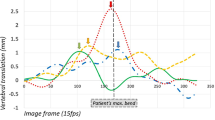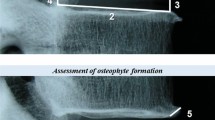Abstract
To determine whether supine 45° oblique radiographs of the cervical spine can accurately detect and quantify anteroposterior intervertebral plane displacements, an observer performance study was performed. A normally aligned dry cervicothoracic vertebral specimen and the same specimen with varying degrees of subluxation at one or more levels were radiographed in anteroposterior, lateral, and 45° oblique projections, in a simulated supine position. Twenty-five sets of radiographs were obtained, of which three were normal. In the remaining 22 sets, there were 43 intervertebral segments with an abnormal anteroposterior displacement. Since each intervertebral level (C2-T1) was individually evaluated, the study sample consisted of 150 intervertebral segments. Blinded to experimental conditions, six observers evaluated every intervertebral level on each lateral and oblique image in isolation. The data for each projection were compared using alternative free-response operator characteristic and free-response forced-error methodologies.
Significant differences in diagnostic accuracy were detected between the horizontal lateral and the supine oblique views to detect malalignment. Although supine oblique views detected many subluxations, they produced numerous false-negative and false-positive results. The findings of this study suggest that supine oblique views may be a useful part of the standard evaluation of the acutely injured cervical spine; however, they may not reliably portray clinically important anteroposterior displacements.
Similar content being viewed by others
References
Collicott PE. Initial assessment of the trauma patient. In: Moore EE, Mattox KL, Feliciano DV, editors. Trauma. 2nd ed. Norwalk, CT: Appleton & Lange, 1991;109–25.
Bohlman HH. Acute fractures and dislocations of the cervical spine: analysis of three-hundred hospitalized patients and review of the literature. J Bone Join Surg Am 1979;61A:1119–42.
Riggins JS, Kraus JF. The risk of neurological injuries with fractures of the vertebrae. J Trauma 1977;17:126–33.
Young JWR, Mirvis SE. Cervical spine trauma. In: Mirvis SE, Young JWR, editors. Imaging in trauma and critical care. Baltimore: Williams & Wilkins, 1992;291–379.
Borock EC, Gabram SGA, Jacobs LM, Murphy AM. A prospective analysis of a two-year experience using computed tomography as an adjunct for cervical spine clearance. J Trauma 1991;31:1001–6.
Marion D, Clifton G. Injury to the vertebrae and spinal cord. In: Moore EE, Mattox KL, Feliciano DV, editors. Trauma. 2nd ed. Norwalk, CT: Appleton & Lange, 1991;261–75.
Edeiken-Monroe BS, Harris JH. Cervical spine trauma. In: Eisenberg RL, editor. Diagnostic imaging: an algorithmic approach. Philadelphia: JB Lippincott, 1988;451–9.
McCall IW, Park WM, McSweeney T. The radiological demonstration of acute lower cervical injury. Clin Radiol 1973;24:235–40.
Abel MS. The exaggerated supine oblique view of the cervical spine. Skeletal Radiol 1982;8:213–9.
Apple JS, Kirks DR, Merten DF, Martinez S. Cervical spine fractures and dislocations in children. Pediatr Radiol 1987;17:45–9.
Swets JA, Pickett RM. The evaluation of diagnostic systems: methods from signal detection theory. New York: Academic Press, 1982.
Bunch PC, Hamilton JF, Sanderson GK, Simmons AH. A free-response approach to the measurement and characterization of radiographic-observer performance. Appl Photogr Eng 1976;4:166–71.
Chakraborty DP, Winter LHL. Free-response methodology: an alternate analysis and a new observer-performance experiment. Radiology 1990;174:873–81.
Campbell MJ, Gardner MJ. Calculating confidence intervals for some non-parametric analyses. In: Gardner MJ, Altman DG, editors. Statistics with confidence: confidence intervals and statistical guidelines. Flushing, NY: Universities Press, 1989;71–9.
Freemeyer B, Knopp R, Piche J, Wales L, Williams J. Comparison of five-view and three-view cervical spine series in the evaluation of patients with cervical spine injury. Ann Emerg Med 1989;18:818–21.
Kreipke DL, Gillespie KR, McCarthy MC, Mail JT, Lappas JL, Broadie TA. Reliability of indications for cervical spine films in trauma patients. J Trauma 1989;29:1438–9.
Author information
Authors and Affiliations
Rights and permissions
About this article
Cite this article
Mann, F.A., Wilson, A.J., McEnergy, K.W. et al. Supine oblique views of the cervical spine: A poor proxy for the lateral view. Emergency Radiology 2, 214–220 (1995). https://doi.org/10.1007/BF02615822
Issue Date:
DOI: https://doi.org/10.1007/BF02615822




